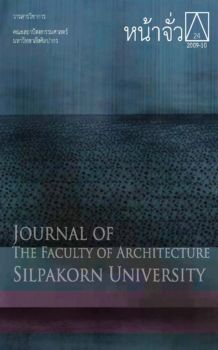การเลี้ยงนกนางแอ่นกินรัง: จากมุมภูมิทัศน์วัฒนธรรมสะท้อนคิด
Abstract
นกนางแอ่นกินรัง เป็นสิ่งมีชีวิตในภาคพื้นอุษาคเนย์ที่ได้ประกอบสร้างสังคมแถบนี้ด้วยสรรพคุณความเชื่อด้านอาหารและยาที่สืบทอดกันมายาวนาน โดยมีถิ่นที่เกาะพักอาศัยทำรังภายในซอกหลืบถํ้าเขาหินปูนที่อยู่ในเกาะต่างๆ ในอ่าวไทยและในบริเวณปากแม่นํ้า ซึ่งเป็นที่อยู่แหล่งอาหารของนกนางแอน่ ในธรรมชาติ ตjอมาไดเ้กิดถิ่นที่อยูใ่หมjของนกนางแอ่นกินรังที่เข้าอาศัยในอาคารที่มนุษย์สร้างขึ้นในเขตชนบทและเมือง และมีการขยายตัวอย่างต่อเนื่อง ซึ่งปรากฏการณ์นี้ส่งผลกระทบต่อพื้นที่ทั้งทางนิเวศวิทยา สังคม และเศรษฐกิจต่อชุมชนที่มีนกเข้าอาศัยเหล่านั้น
บทความมุ่งศึกษาปัจจัยที่สัมพันธ์กับการเลี้ยงนกนางแอ่นกินรังที่ปรากฏในภูมิทัศน์วัฒนธรรมของพื้นที่คาบสมุทรของไทย ภูมิทัศน์ในการเลี้ยงนกนางแอ่นกินรังในพื้นที่มีความสัมพันธ์เชิงระบบ และแนวทางในการลดผลกระทบและส่งเสริมการเลี้ยงนกนางแอ่นให้เกิดความยั่งยืน โดยอาศัยขอ้ มูลปฐมภูมิและทุติยภูมิจากการวิจัยเรื่องภูมิทัศนว์ ัฒนธรรมลุม่ น้ำเพชรบุรีซึ่งเปน็ โครงการวิจัยย่อยในกลุ่ม วิจัยโครงการการศึกษาเพื่ออนุรักษแ์ ละพัฒนาสิ่งแวดล้อมสรรคส์ร้างลุ่มน้ำเพชรบุรี อำนวยการชุดโครงการโดย ศาสตราจารย์เกียรติคุณ อรศิริ ปาณินท์ มหาวิทยาลัยเกษตรศาสตร์
การเลี้ยงนกนางแอ่นจากอดีตถึงปัจจุบันได้พัฒนา ขยายสถานะของคุณค่าที่มีต่อมนุษย์จากการเป็นเพียงสินค้าที่มีคุณค่าในทางเศรษฐกิจและกลายมาเป็นสินค้าสัญญะทางวัฒนธรรม แต่อย่างไรก็ตามการเลี้ยงนกนางแอ่นกินรังก็ยังอาจเป็นองค์ประกอบที่ช่วยสร้างความสมดุลทางนิเวศวิทยา เศรษฐกิจท้องถิ่น ซึ่งคุณค่าด้านต่างๆของนกนางแอ่นกินรังและการเลี้ยงนกนางแอ่นกินรังนั้น มีความสัมพันธ์ที่ส่งผลต่อเนื่องซึ่งกันและกัน หากสิ่งต่างๆ เหล่านี้ได้รับการจัดการที่เหมาะสม การเลี้ยงนกนางแอ่นก็จะเป็นประโยชน์ต่อมนุษย์และสิ่งแวดล้อมได้อย่างยั่งยืน
Urban Farming of Edible-nest Swiftlet on Refl exive Cultural Landscape
Saran Samantarat, Ornaim Tangkij-ngamwong, Ass.Prof. Sani Limthongsakul, Olarn Charaenchai
Faculty of Architecture, Kasetsart University
Pawin Sirisalee (M.LA.)
TA., Faculty of Architecture, Thamasart University
Edible-nest swiftlet (Collocalia fuciphaga), a mysterious bird of the World History, lives in Southeast Asia. Its famous nest has been announced as an ambrosial medical food.
Domesticating in caves near the river and sea, the edible-nest swiftlet initially sustain its life by those enormous insects found in the local habitat. Later, there was new habitat unintentionally emerged from human shelters in delta town area. This phenomenon has both impact and profit to each place in terms of economic, sociological and ecological aspects. This paper is interested in several relativity of sheltering edible-nest swiftlet in deep Gulf of Thailand and system dynamic of cultural landscape approached both pros and cons with sustainability. Collaborative secondary data was obtained from World crisis El nino in South-East Asia. Primary data was collected from a sub group research “Cultural Landscape in Phetchaburi Basin” under the main title called “The Study for Conservation and Development of the Built Environment in Phetchaburi Basin”, granted by National Research Council of Thailand 2007 and directed by Emeritus Professor Ornsiri Panin, Kasetsart University.
Edible-nest swiftlet farming developed from time to time, from economic commodity to a cultural agent. In the mean time, this farming business can become an interesting factor to balance the threesome of local economy, sociology, and
ecology which leads to sustainable development. This knowledge, if properly managed, will lead to beneficial win-win business and sustainable development for both human and nature.





